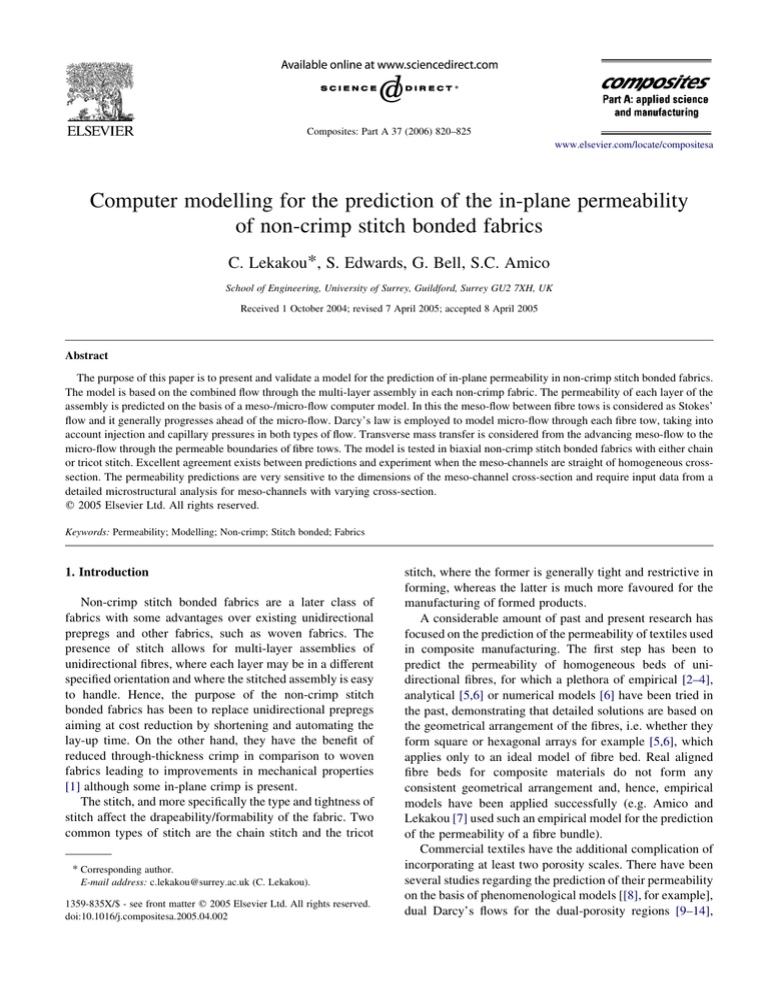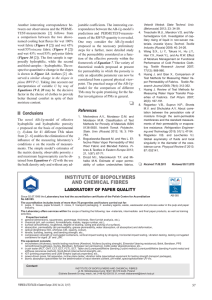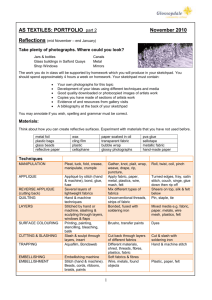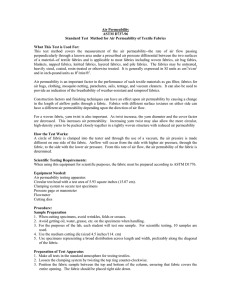
Composites: Part A 37 (2006) 820–825
www.elsevier.com/locate/compositesa
Computer modelling for the prediction of the in-plane permeability
of non-crimp stitch bonded fabrics
C. Lekakou*, S. Edwards, G. Bell, S.C. Amico
School of Engineering, University of Surrey, Guildford, Surrey GU2 7XH, UK
Received 1 October 2004; revised 7 April 2005; accepted 8 April 2005
Abstract
The purpose of this paper is to present and validate a model for the prediction of in-plane permeability in non-crimp stitch bonded fabrics.
The model is based on the combined flow through the multi-layer assembly in each non-crimp fabric. The permeability of each layer of the
assembly is predicted on the basis of a meso-/micro-flow computer model. In this the meso-flow between fibre tows is considered as Stokes’
flow and it generally progresses ahead of the micro-flow. Darcy’s law is employed to model micro-flow through each fibre tow, taking into
account injection and capillary pressures in both types of flow. Transverse mass transfer is considered from the advancing meso-flow to the
micro-flow through the permeable boundaries of fibre tows. The model is tested in biaxial non-crimp stitch bonded fabrics with either chain
or tricot stitch. Excellent agreement exists between predictions and experiment when the meso-channels are straight of homogeneous crosssection. The permeability predictions are very sensitive to the dimensions of the meso-channel cross-section and require input data from a
detailed microstructural analysis for meso-channels with varying cross-section.
q 2005 Elsevier Ltd. All rights reserved.
Keywords: Permeability; Modelling; Non-crimp; Stitch bonded; Fabrics
1. Introduction
Non-crimp stitch bonded fabrics are a later class of
fabrics with some advantages over existing unidirectional
prepregs and other fabrics, such as woven fabrics. The
presence of stitch allows for multi-layer assemblies of
unidirectional fibres, where each layer may be in a different
specified orientation and where the stitched assembly is easy
to handle. Hence, the purpose of the non-crimp stitch
bonded fabrics has been to replace unidirectional prepregs
aiming at cost reduction by shortening and automating the
lay-up time. On the other hand, they have the benefit of
reduced through-thickness crimp in comparison to woven
fabrics leading to improvements in mechanical properties
[1] although some in-plane crimp is present.
The stitch, and more specifically the type and tightness of
stitch affect the drapeability/formability of the fabric. Two
common types of stitch are the chain stitch and the tricot
* Corresponding author.
E-mail address: c.lekakou@surrey.ac.uk (C. Lekakou).
1359-835X/$ - see front matter q 2005 Elsevier Ltd. All rights reserved.
doi:10.1016/j.compositesa.2005.04.002
stitch, where the former is generally tight and restrictive in
forming, whereas the latter is much more favoured for the
manufacturing of formed products.
A considerable amount of past and present research has
focused on the prediction of the permeability of textiles used
in composite manufacturing. The first step has been to
predict the permeability of homogeneous beds of unidirectional fibres, for which a plethora of empirical [2–4],
analytical [5,6] or numerical models [6] have been tried in
the past, demonstrating that detailed solutions are based on
the geometrical arrangement of the fibres, i.e. whether they
form square or hexagonal arrays for example [5,6], which
applies only to an ideal model of fibre bed. Real aligned
fibre beds for composite materials do not form any
consistent geometrical arrangement and, hence, empirical
models have been applied successfully (e.g. Amico and
Lekakou [7] used such an empirical model for the prediction
of the permeability of a fibre bundle).
Commercial textiles have the additional complication of
incorporating at least two porosity scales. There have been
several studies regarding the prediction of their permeability
on the basis of phenomenological models [[8], for example],
dual Darcy’s flows for the dual-porosity regions [9–14],
C. Lekakou et al. / Composites: Part A 37 (2006) 820–825
and a mixed flow model including a Stokes’ flow model in
the meso-channels and Darcy’s flow within the porous fibre
tows [15–19]. However, it has been realised that it may be
very difficult to predict permeability values for textiles that
agree well with experimental measurements for a variety of
reasons. Experiments to measure in-plane permeability may
involve well-documented process errors ranging from 8%
[20] to 24% [21]. The permeability of textiles is greatly
affected by their geometrical dimensions and architecture
[22–24], which means the accurate measurement of the
geometrical parameters associated with the textile microstructure and any spatial variations of such parameters in the
same or different batches of textiles are expected to affect
both predicted and measured permeability values. As a
result, detailed CAD models of textile architectures have
been generated by several groups [24,25]. However, only
qualitative agreement between predictions and experiment
has been reached to date for the permeability of textiles. A
successful case involves the prediction of the in-plane
permeability of textiles as a function of shear angle, for
which good agreement has been achieved [26,27] between
predictions and experimental data provided that the
predictions are based on the measured permeability of the
unsheared textile.
The present study focuses on the prediction of the inplane permeability of the non-crimp fabrics as it has been
thought that they have simpler design than other commercial textiles, where each layer may be possibly assumed as a
unidirectional fibre layer. The stitching process creates
meso-channels between the fibre tows yielding a dualporosity fabric, overall. Amico and Lekakou [19] developed
a permeability model, implemented in a computer code,
which allows the prediction of in-plane permeability
parallel to the fibres for assemblies of fibre tows characterised by meso-channels, between the fibre tows, and microchannels between the fibres within each tow. This computer
model has been successfully validated with respect to both,
advancing meso-flow and micro-flow. This is particularly
important since past studies, particularly focusing on noncrimp fabrics [28], have encountered specific problems in
the experimental validation of model predictions attributed
to insufficient characterisation and modelling of the
structure of the porous medium [28].
The present study has extended this computer model
[19], based on the combination of meso- and micro-flow, to
multi-layer, non-crimp stitch bonded fabrics in order to
predict their in-plane permeability. The predictions are
compared with corresponding experimental in-plane permeability data for a 08/908 biaxial fabric with tricot stitch
and G458 biaxial fabrics with either chain or tricot stitch.
2. Permeability model
Fig. 1 illustrates an example of the cross-section of a
polymer composite with assemblies of a non-crimp G458
821
Fig. 1. Cross-section of polymer composite with assemblies of G45 noncrimp fabric EBX936 (with chain stitch) and the system of coordinates used
in the flow model.
fabric. Each layer in a non-crimp stitch bonded fabric was
considered as an array of parallel fibre tows with mesochannels between the tows, where the meso-channels and
the tows were assumed to be of rectangular and elliptical
cross-section, respectively [19]. Axial Stokes’ flow was
considered in the meso-channels and Darcy’s law was
applied within the porous fibre tows, taking into account
injection pressure and capillary pressure in both types of
flow. Transverse flow transfer was modelled from the
leading flow front to the lagging flow and a partial-slip
boundary condition was applied at the permeable boundaries of meso-channels.
The Stokes’ flow model applied to the meso-flow is
described by
V2 U C
G
Z0
m
(1)
Boundary conditions: UZ0 at zZGb and UZub at yZ
Ga where U is the velocity in the x direction and
GZKdP/dx is a constant pressure gradient in the direction
of the positive x-axis, m is the viscosity of the filling
Newtonian fluid, and a and b are the meso-channel halfwidth and half-height, respectively. Eq. (1) was solved using
an auxiliary function, separation of variables, Fourier
analysis and the boundary conditions [19,29], yielding the
following equation for the fluid velocity in the mesochannel
2
0
1
N
X
G 4 2
b b 4 sin bn b A
@ 2ub sin
n K
Uðy; zÞ Z
b K z2 C
G
2m
bb3n
nZ0
2m bbn
3
cos hbn y
!
cos bn z5
ð2Þ
cos hbn a
822
C. Lekakou et al. / Composites: Part A 37 (2006) 820–825
where
bn Z ð2n C 1Þ
p
2b
(3)
and ub is given by the partial slip boundary condition
derived in [19], following theory and empirical relations
presented by Beavers and Joseph [30] and Huang et al. [31].
The meso- and micro-flowrates, Qme and Qmi, respectively, are given by
ða ðb
Qme Z
Uðy; zÞdz dy K Qtransfer
(4)
Ka Kb
Qmi Z
kmia At ðPc;mia C Pinj Þ
C Qtransfer
mxmia
(5)
Fig. 2. Model of a two-layer assembly of a non-crimp fabric.
where At is the cross-section of the elliptical tow, kmia is the
axial micro-permeability in the fibre tow, Pc,mia is the axial
capillary pressure in the fibre tow, Pinj is the injection
pressure and xmia is the progress of the micro-flow in the
x-direction.
In this study, the meso-flow is assumed to lead the
Darcy’s micro-flow and hence flow transfer is considered
from the leading flow in the meso-channels to the microflow at the porous interface of each fibre tow, governed by
Darcy’s law:
qffiffiffiffiffiffiffiffiffiffiffiffiffi
ðR2aCR2b Þ
kmit ðPc;mit C PÞðxme K xmia Þ
2p
2
Qtransfer Z
(6)
0:5mRe
where pððR2a C R2b Þ=2Þ1=2 is half the perimeter of the
elliptical tow, Re is the radius of an equivalent cylindrical
tow, kmit is the transverse micro-permeability of the
fibre tow, Pc,mit is the transverse capillary pressure in the
fibre tow and P is the local pressure (in the meso-channel if
the meso-flow leads or in the micro-flow if the latter leads).
Since the depth of tow impregnation varies from 0 at xme (no
tow impregnation) to Re at xmia (full tow impregnation), an
approximate average depth of tow impregnationZ0.5 Re
has been assumed in Eq. (6).
The flow through the multi-layer assembly of the noncrimp fabric was modelled as the total of parallel flows
through each layer [26], in the direction of the total flow (see
Fig. 2), so that the total permeability, Ktot, was given by the
average of permeabilities if all layers were assumed to be of
the same thickness:
P
K H
Ktot Z P Li Li
(7)
HLi
where KLi and HLi are the permeability and thickness of
layer i.
If the fibre direction in layer i was parallel to the total
flow direction, the permeability KLi was calculated on the
basis of the computer model by Amico and Lekakou
[19], represented by Eq. (1)–(6). If the fibre direction in
layer i was at 908 with respect to the total flow direction,
the permeability KLi,T is given by the relation
1 X Lmes;i X Lmicro;i K1
KLi;T Z
C
LTot
Kmes;i
kmit
(8)
where
L Tot
P is the total flow length, LTotZ
P
Lmes;i C Lmicro;i , kmit is the transverse permeability
of fibre tow and
Kmes;i Z
b2
3
(9)
where 2b is the height of the rectangular meso-channel in
layer i.
3. Experiments
The experiments included in-plane permeability
measurements in an RTM mould with central injection
(radial outward flow) at a constant injection pressure of
0.2 MPa. The radial outward flow method was preferred for
the measurement of the in-plane permeability as it is quick,
leading to the determination of both principal in-plane
permeabilities in a single flow experiment, and there are no
risks of flow racing effects at the sides of the fabric
assembly, as is sometimes the case in rectilinear flow with
side injection. Six layers of non-crimp stitch bonded fabrics
were used in each permeability experiment, and no central
hole was cut for the injection so as not to disturb the
continuity of the fabric microstructure. Silicone oil was used
as the infiltrating liquid in each permeability experiment.
Table 1
Non-crimp stitch bonded fabrics used in this study
Fabric code
EBX936
EBXhd936
ELT850
Fibre
type
Glass
Glass
Glass
Percentage of each ply
Stitch
type
08
908
C458
K458
–
–
502
–
–
501
501
501
–
502
502
–
Chain
Tricot
Tricot
C. Lekakou et al. / Composites: Part A 37 (2006) 820–825
823
Fig. 5. Fabric structure of EBX936 non-crimp stitch bonded fabric; arrowheads indicate the meso-channels
Fig. 3. The 908 layer of ELT850 non-crimp stitch bonded fabric.
After the permeability experiment, a curing Araldite epoxy
was injected to make an RTM laminate which was used to
measure total thickness, H, fibre volume fraction, Vf and
geometrical parameters of the fibres, fibre tows and mesochannels in microstructural analyses of mosaics of micrographs using the UTHSCSA ImageTool. The measured Vf
for the various laminates was within the range of 54–56%.
Three types of non-crimp stitch bonded glass fibre fabrics
were used as presented in Table 1. EBX936 and EBXhd936
were G458 biaxial fabrics whereas ELT850 was a 08/908
biaxial fabric. EBX936 had chain stitch whereas the other
two fabrics had tricot stitch.
In-plane microstructural measurements for each fabric,
on each side, included the meso-channel width, 2a, and
were performed on dry, uncompressed samples of fabric of
50!50 mm. Past measurements on assemblies of a plain
woven fabric [32] showed that the width of bundles does not
change with compression up to a VfZ0.57 and increases
thereafter up to a maximum VfZ0.63 (at a pressure of
1.77 MPa). Compression tests on assemblies of a non-crimp
stitch bonded fabric [33] demonstrated that a VfZ0.55
represents medium compression, whereas a maximum VfZ
0.63 is reached at a pressure of 1.77 MPa. Hence, in this
study it is assumed that the width of meso-channels and
bundles does not change up to the medium compression of
VfZ0.55, used in this study.
Fig. 4. The 08 layer of ELT850 non-crimp stitch bonded fabric.
Figs. 3 and 4 demonstrate the in-plane microstructure of
each side of ELT850 08/908 non-crimp stitch bonded fabric.
Continuous meso-channels were assumed in the microstructural analysis of each side of this fabric. In the digital
image processing (using the UTHSCSA ImageTool),
regular measurements of the meso-channel width, 2a,
were made (about 10 such measurements along the mesochannel between consecutive stitches), and the total
averaging yielded 2aave.
Figs. 5 and 6 demonstrate the in-plane microstructure of
G458 fabrics EBX936 and EBXhd936. It is clear that in
both these fabrics the meso-channels are mainly discontinuous, consisting generally of ‘an eye’ around the needle
point of the stitch. These ‘eyes’ have been approximated by
elliptical meso-channel shapes, of major and minor axes ea
and eb, respectively, and have been considered to be at a
distance ed on the same line (see Fig. 7). Hence, ea, eb and ed
have been measured for each ‘eye’ i, and for each eye an
average meso-channel width is calculated as eb,aveZ(peb)/4
which is supposed to be homogeneous for a length ea. The
total average meso-channel width is then calculated as
P
e
e
P a;i
2aave Z P i b;ave;i
e
C
i a;i
i ed;i
(10)
Fig. 6. Fabric structure of EBXhd936 non-crimp stitch bonded fabric;
arrow-heads indicate the meso-channels
824
C. Lekakou et al. / Composites: Part A 37 (2006) 820–825
Fig. 7. Diagram presenting the microstructural measurement technique and the measured parameters to determine the meso-channel width for EBX936 and
EBXhd936. The ellipses represent the discontinuous meso-channels formed arsound the stitch. A continuous meso-channel model (dotted line) is used in the
in-plane permeability predictions, represented by a constant width 2aave.
Table 2
Results of the predicted and measured permeabilities of the tested non-crimp stitch bonded fabrics
Fabric code
Predicted permeability (m2)
Measured permeability (m2)
Predicted permeability (m2)
Measured permeability (m2)
ELT850
EBX936, amax
EBX936, aave
EBXhd936 amax
EBXhd936 aave
K90 Z1.48!10
KK45Z1.14!10K11
KK45Z5.38!10K12
KK45Z6.62!10K12
KK45Z5.51!10K12
K90 Z1.48!10
KK45Z5.42!10K12
KK45Z5.42!10K12
KK45Z5.52!10K12
KK45Z5.52!10K12
KC45Z2.41!10K11
KC45Z6.54!10K12
KC45Z2.14!10K12
KC45Z3.02!10K12
KC45Z6.54!10K12
KC45Z6.54!10K12
KC45Z3.00!10K12
KC45Z3.00!10K12
K11
K11
The height of meso-channels and fibre tows have been
measured in cross-sections of the laminates obtained at each
permeability measurement. Hence, these measurements
include the compression effect (Vf effect) in the permeability
experiments for all fabrics.
and 2aC45,maxZ3.34!10K4 m, the predicted permeabilities varied significantly from the measured values, as
presented in Table 2. By using the average measured
values given by Eq. (10), 2aK45,aveZ1.68!10K4 m and
2a C45,ave Z1.88!10K4 m, excellent agreement was
reached between predictions and experiment. The same
occurred with EBXhd936, where
4. Results and discussion
2aK45;max Z 2:37 !10K4 m
and
Table 2 presents the results of the predicted and
measured permeabilities for the three fabrics, where for
easy comparison all results have been extrapolated to the
permeability corresponding to VfZ0.55, using the Carman–
Kozeny relationship. Parametric studies showed that the
predicted permeabilities were very sensitive to the value of
meso-channel width. Since each biaxial fabric was orthogonal, each fabric demonstrated two principal in-plane
permeabilities in the two axial fabric directions. Each of
the two principal in-plane permeabilities depended primarily on the geometrical parameters of the fabric layer with
meso-channels and tows parallel to the direction of that
principal permeability.
Starting with the 08/908 biaxial fabric ELT850, one of the
two layer directions (908) proved most appropriate for
validating the permeability model, since it had regular and
straight meso-channels (see Fig. 3). Using an average
measured meso-channel width, 2aZ3.8!10K4 m, the
predicted permeability, K90, agreed exactly with the
measured permeability value. No attempt was made to
predict K0 for ELT850, due to the most irregular structure
and statistical variation in the geometrical parameters of the
08 layer (see Fig. 4).
The meso-channels of EBX936 and EBXhd936 were not
at all straight, as shown in Figs. 5 and 6, although the inplane permeability model used continuous meso-channels
of constant width and height (see Section 2). When
representative maximum values of the measured minor
axes of the meso-channel ‘eyes’ were used in the permeability model for EBX936, 2aK45,maxZ2.37!10K4 m
2aC45;max Z 1:53 !10K4 m
and
2aK45;ave Z 2:15 !10K4 m
and
2aC45;ave Z 1:85 !10K4 m:
Hence, it was concluded that the in-plane permeabilities
of each fabric were very sensitive to the magnitude of the
meso-channel cross-section, especially the meso-channel
width which would vary significantly along the length of the
meso-channel, due to the periodic presence of the stitch.
Fig. 8 shows an example of a parametric study regarding the
variation of the predicted in-plane principal permeabilities
as a function of the input value for the meso-channel width
of the fabric EBX936.
Fig. 8. Parametric study of the variation of the principal in-plane
permeabilities in EBX936 non-crimp stitch bonded fabric as a function
of the meso-channel width.
C. Lekakou et al. / Composites: Part A 37 (2006) 820–825
5. Conclusions
A model has been presented for the prediction of the inplane permeability of biaxial non-crimp stitch bonded
fabrics based on the assembly of flow units in parallel (for
different layers) or in series, whereas the prediction of the
permeability of each layer along the fibre direction is based
on a meso-/micro-flow model [19]. Successful permeability
predictions in comparison with experimental data were
achieved for straight meso-channels as in the 908 direction
of fabric ELT850.
However, several stitched fabrics display a large extent
of in-plane waviness and the width of their meso-channel
has a large effect on their permeability. As a result, detailed
microstructural analysis is required to determine average
meso-channel dimensions, which when inputted in the
computer model yielded in-plane permeability predictions
in good agreement with experimental data for a Vf around
55%. This represents a medium degree of compression.
Much lower Vf values due to low compression might result
in interlayer meso-channels, which have not been taken into
account in the permeability model in this study. Much
higher Vf values, around 60%, might involve change of inplane geometric parameters in the fabric architecture (mesochannel width, for example) as a function of compression,
and hence they would require measurement of in-plane
geometric parameters in compressed fabric samples.
References
[1] Hogg PJ, Bibo GA, Kemp M. Mechanical characterisation of glassand carbon-fibre reinforced composites made with non-crimp fabrics.
Compos Sci Technol 1997;57(9–19):1221–41.
[2] Williams JG, Morris CEM, Ennis BC. Liquid flow through aligned
fiber beds. Pol Eng Sci 1974;14(6):413–9.
[3] Lam RC, Kardos JL. The permeability and compressibility of aligned
and cross-plied carbon-fiber beds during processing of composites.
Pol Eng Sci 1991;31(14):1064–70.
[4] Batch GL, Chen Y-T, Macosko CW. Capillary impregnation of
aligned fibrous beds: experiments and model. J Reinf Plastics Compos
1996;15:1027–51.
[5] Gebart BR. Permeability of unidirectional reinforcements for RTM.
J Compos Mater 1992;26(8):1100–33.
[6] Skartsis L, Khomani B, Kardos JL. Resin flow through fiber beds
during composite manufacturing processes. Part II: numerical and
experimental studies of Newtonian flow through ideal and actual fiber
beds. Pol Eng Sci 1992;32(4):231–9.
[7] Amico SC, Lekakou C. Axial impregnation of a fibre bundle. Part 2.
Theoretical analysis. Polym Compos 2002;23(2):264–73.
[8] Dave R. A unified approach to modelling resin flow during composite
processing. J Compos Mater 1990;24(1):22–41.
[9] Chan AW, Morgan RJ. Tow impregnation during resin transfer
moulding of bi-directional nonwoven fabrics. Polym Compos 1993;
14(4):335–40.
[10] Calhoun DR, Yalvac S, Wetters DG, Wu C-H, Wang TJ, Tsai JS, et al.
Mould filling analysis in resin transfer moulding. Polym Compos
1996;17(2):251–64.
825
[11] Gauvin R, Trochu F, Lemmen Y, Diallo L. Permeability measurement
and flow simulation through fibre reinforcement. Polym Compos
1996;17(1):34–42.
[12] Vankan WJ, Huyghe JM, Drost MR, Janssen JD, Huson A. A finite
element mixture model for hierarchical porous media. Int J Numer
Meth Eng 1997;40:193–210.
[13] Lekakou C, Bader MG. Mathematical modelling of macro- and microinfiltration in resin transfer moulding (RTM). Compos A 1998;29A:
29–37.
[14] Acheson JA, Simacek P, Advani SG. The implications of fiber
compaction and saturation on fully coupled VARTM simulation.
Compos A 2004;35(2):159–69.
[15] Bruschke MV, Advani SG. Flow of generalised Newtonian fluids
across a periodic array of cylinders. J Rheol 1993;37(3):479–98.
[16] Phelan Jr FR, Leung Y, Parnas RS. Modelling of microscale flow in
unidirectional fibrous porous media. J Thermoplastic Compos 1994;7:
208–18.
[17] Simacek P, Advani SG. Permeability model for a woven fabric. Polym
Compos 1996;17(6):887–99.
[18] Van der Westhuizen J, Du Plessis JP. An attempt to quantify fibre bed
permeability utilising the phase average Navier-Stokes equation.
Compos A 1996;27(4):263–9.
[19] Amico S, Lekakou C. Flow through a two-scale porosity, oriented
fibre porous medium. Transport Porous Med 2004;54(1):35–53.
[20] Heardman E, Lekakou C, Bader MG. Flow monitoring and
permeability measurement under constant and transient flow conditions. Compos Sci Technol 2004;64(9):1239–49.
[21] Lundstrom TS, Stenberg R, Bergstrom R, Partanen H, Birkeland PA.
In-plane permeability measurements: a nordic round-robin study.
Compos A 2000;31(1):29–43.
[22] Pearce NRL, Guild FJ, Summerscales J. An investigation into the
effects of fabric architecture on the processing and properties of fibre
reinforced composites produced by resin transfer moulding. Compos
A 1998;29(1–2):19–27.
[23] Hoes K, Dinescu D, Sol H, Parnas RS, Lomov S. Study of nesting
induced scatter of permeability values in layered reinforcement
fabrics. Compos A 2004;35(12):1407–18.
[24] Lomov SV, Huysmans G, Luo Y, Parnas RS, Prodromou A,
Verpoest I, et al. Textile composites: modelling strategies. Compos
A 2001;32(10):1379–94.
[25] Robitaille F, Long AC, Jones IA, Rudd CD. Automatically generated
geometric descriptions of textile and composite unit cells. Compos A
2003;34(4):303–12.
[26] Heardman E, Lekakou C, Bader MG. In-plane permeability of sheared
fabrics. Compos A 2001;32:933–40.
[27] Endruweit A, Ermani P. The in-plane permeability of sheared textiles.
Experimental observations and a predictive conversion tool. Compos
A 2004;35(4):439–51.
[28] Lundstrom TS. The permeability of non-crimp stitch bonded fabrics.
Compos A 2000;31(12):1345–53.
[29] Langlois WE. Slow viscous flow. New York: Macmillan; 1964.
[30] Beavers GS, Joseph DD. Boundary conditions at a naturally
permeable wall. J Fluid Mech 1967;30(1):197–207.
[31] Huang L-H, Chiang I-L, Song C-H. A reinvestigation of laminar
channel flow passing over porous bed. J Chin Inst Eng 1997;20(4):
435–41.
[32] Saunders RA, Lekakou C, Bader MG. Compression and microstructure of fibre plain woven cloths in the processing of polymer
composites. Compos A 1998;29A(4):443–54.
[33] Saunders RA, Lekakou C, Bader MG. Compression in the processing
of polymer composites. 1. A mechanical and microstructural study for
different glass fabrics and resins. Compos Sci Technol 1999;59(7):
983–93.





